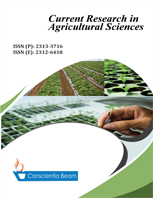Combining ability of maize (Zea mays l.) inbred lines adapted to sub-humid central highland of Ethiopia
DOI:
https://doi.org/10.18488/cras.v11i1.3771Abstract
The production of maize, a primary food crop in Africa, is hampered by a lack of high-yielding cultivars, biotic and abiotic stressors. In order to create high-yielding maize varieties, choosing promising germ plasm that have good combining ability, and heterotic groups is so important. Estimating the GCA and SCA of grain yield and other yield-related traits of maize inbred lines was the goal of this work. In 2019 using line by tester mating design, 26 inbred lines were crossed with two testers to produce 52 F1 hybrids. The experiment was carried out in the Ambo and Kulumsa Agricultural Research Centres in the 2020 cropping season using an alpha lattice design with two replications. Analysis of variance revealed significant mean squares attributable to crosses and lines in each location and across locations for targeted traits. The finding of the line x tester ANOVA showed significant mean squares for lines, testers, and cross for grain yield, anthesis date, silking date, plant height, ear height, kernel row per ear, and number of ears per plant. This show inconsistency of inbred lines traits across testing sites. While crossings L1xT2, L17xT1, L8xT1, L10xT1, L14xT1, L20xT2, L24xT2, and L26xT1 were effective particular combiners, inbred L2, L4, L5, L7, L10, and L13 were strong general combiners for grain yield. The best particular combiners for plant and ear height traits were L11xT1, L17xT1, and L11xT1, L26xT2, while L14, L21, and L22 worked well for EPP and L14 for KPR with T1.

